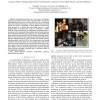Free Online Productivity Tools
i2Speak
i2Symbol
i2OCR
iTex2Img
iWeb2Print
iWeb2Shot
i2Type
iPdf2Split
iPdf2Merge
i2Bopomofo
i2Arabic
i2Style
i2Image
i2PDF
iLatex2Rtf
Sci2ools
HRI
2010
ACM
2010
ACM
Cooperative gestures: effective signaling for humanoid robots
Abstract—Cooperative gestures are a key aspect of humanhuman pro-social interaction. Thus, it is reasonable to expect that endowing humanoid robots with the ability to use such gestures when interacting with humans would be useful. However, while people are used to responding to such gestures expressed by other humans, it is unclear how they might react to a robot making them. To explore this topic, we conducted a withinsubjects, video-based laboratory experiment, measuring time to cooperate with a humanoid robot making interactional gestures. We manipulated the gesture type (beckon, give, shake hands), the gesture style (smooth, abrupt), and the gesture orientation (front, side). We also employed two measures of individual differences: negative attitudes toward robots (NARS) and human gesture decoding ability (DANVA2-POS). Our results show that people cooperate with abrupt gestures more quickly than smooth ones and front-oriented gestures more quickly than those made to the side, pe...
| Added | 17 May 2010 |
| Updated | 17 May 2010 |
| Type | Conference |
| Year | 2010 |
| Where | HRI |
| Authors | Laurel D. Riek, Tal-Chen Rabinowitch, Paul Bremner, Anthony G. Pipe, Mike Fraser, Peter Robinson |
Comments (0)

